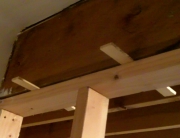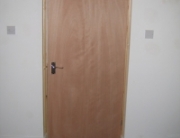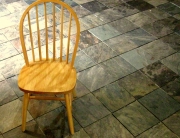A step-by-step how-to guide on how to remove an old toilet and install a new one in your home. These instructions accompany the video “How to Install a Toilet” at See Jane Drill.
Tools & Materials Needed
- Adjustable Wrench
- Hand multi-tool OR a Phillips and flathead screwdriver
- Tongue-and-groove pliers (a.k.a. channel locks)
- Utility Knife
- Clamp
- Scrapers (1 or 2)
- New Toilet, preferably an “easy-installation” model. Important Note: Before purchasing the new toilet, measure the distance between the wall and the flange bolt on the existing toilet. This distance should measure 12 inches or 1 foot on most toilets. However, if your toilet sits closer or further from the wall, you will need to special-order a new toilet from your local home-improvement store.
- New water supply line that is the correct length for the distance between the tank of the new toilet and the water shut-off valve (if needed)
- New toilet seat, if not provided in the package with the new toilet
- Wax ring and flange bolts, if not provided in the package with the new toilet
- Paper Towels
- Bucket
- Large Sponge
- Plastic Garbage Bags
- Plastic Tarp (disposable)
- Old Rags
- Disposable Plastic Gloves
- Anti-bacterial cleaner or wipes
- Blue masking or painters tape
• Special Requirements
Allow yourself at least three hours to complete this task. It may not take that long, but you don’t want to rush yourself
Also, installation of the new toilet will require two persons to complete that portion of the job
Steps to Remove Old Toilet
1. General Notes: It is a good idea to clean the area around the toilet with antibacterial cleaner, prior to beginning the job. Also, wear comfortable clothing that you don’t mind getting dirty.
2. Shut off Water and Disconnect Water Supply Line:
a. Turn the handle on the shut-off valve to the water supply line to the “off” position. Make sure it is tightly turned off. If you don’t have a shut-off valve, you will need to turn off the water at the water meter. This would also be true if your shut-off valve is broken and/or stuck in the “on” position.
b. Flush the toilet to remove most of the water from the tank.
c. Take lid off the tank, and with a large sponge, sop up any remaining water in the tank, and dispose of the water.
d. Check the bowl to see if there is any remaining water. If there is, sop up the water with a large sponge so that the bowl is nearly dry.
e. Disconnect the water supply line from the tank. Make sure your bucket is handy. Depending upon the toilet that you have, you might be able to unscrew it by hand, or you may need to use a tool on it such as channel locks or an adjustable wrench.
f. When you pull off the water supply line from the tank, there may be water dripping from it. If there is, just clamp the line to the bucket as shown below.
3. Remove the Existing Toilet:
a. First, you will need to remove the caps that are over the two flange bolts that are holding the toilet to the floor. Inspect the nuts. Depending upon their condition, their removal could go quickly or could be a bit time-consuming. The video shows examples of both a badly rusted nut, and one that is in good condition.
i. For the good condition bolt: The nut should be easily removed with a wrench or channel locks. Then remove the bolt and the washer.
ii. For the rusted bolt: Attempt to remove the nut with channel locks or a wrench. If that is not possible, you will need to cut the bolt off with a hack saw or an oscillating multi tool with a wood/metal flush-cut blade.
b. Lay a plastic tarp next to the toilet, and then place an opened garbage bag on top of the tarp. The idea is that the base of the old toilet will be inside the garbage bag, with the bag wrapped around it for removal.
i. Important Note: The toilet is very heavy (50-plus pounds) and is awkwardly shaped. It is possible to move the toilet alone, as shown in the video, but if you have help to move the toilet, by all means use it.
c. Lift the toilet up and set it on the opened plastic bag.
d. Note: There are several ways to dispose of an old toilet. You can take it to the dump, or you can break it down into pieces and dispose of it in the trash.
Steps to Install the New Toilet
1. Clean-up and Removal of Old Wax Ring
a. Important Safety Note: Place an old rag inside the opening to the sewer line, to prevent sewer gasses from entering the house.
b. Wearing rubber gloves, scrape up and dispose of the old wax ring. Depending upon the condition of the old wax ring, this could go quickly or take a few minutes.
c. If the plastic portion of the wax ring has separated from the wax, remove and dispose of it.
d. Clean up the area around the flange, preferably with anti-bacterial cleaner.
2. Important Note about the flange and the surrounding floor area: Your flange and floor may be in good condition, as those in the video were. In the event that the flange is damaged, you may need to replace the flange or install an “adaptable flange” over the old flange. Flanges are available from most large home-improvement stores.
Please note that it is critical that the floor beneath the toilet be in sound condition. If there are signs of rotted wood in the floor (such as if the old toilet was rocking) the rotted wood will need to be replaced. If you feel comfortable with removing the rotted wood and replacing it, this is the time to do so. If not, you will need to seek assistance in replacing the rotted wood.
3. Distance from the wall: Double-check to ensure that the opening to the flange on your toilet is 12 inches or 1 foot from the wall. (See resources list for instructions regarding toilets that are situated further or closer from the wall)
4. The flange bolts. The existing flange bolts may be in good condition, in which case you will not have to install new ones. If you do need to install new flange bolts, you will note that the flange bolt is oblong-shaped to match the hole in the curved channel in the flange. Insert, slide, and twist the bolt. If the flange bolt is wobbling, you can steady it with a washer, but it may not be necessary. See picture below.
5. Measure and mark the floor. Make sure the flange bolt is 12 inches from the wall. Mark the spot with a heavy black marker, and then lay a blue tape line as well. Extend your mark along the tape. The blue tape line will assist you with positioning the new toilet over the flange bolts during the installation, as you will not be able to see the flange bolts from above.
6. Install the new wax ring. There are two options for doing this. You can either stick it on the bottom of the toilet (as most manufacturers suggest) or lay it over the flange. Either choice will work.
7. Important Note: The next step, installing the new toilet, requires two people.
8. Lift the toilet and put it into position, making sure that the slots on the new toilet line up with the flange bolts.
9. Sit on the toilet to compress the wax ring and ensure that it seals properly.
10. Bolt the toilet to the floor by installing the flange bolt nuts that come with the toilet, as per the manufacturer’s instructions. It is important to not over-tighten the nuts, as the porcelain could crack.
11. Install the new caps over the flange bolts/nuts.
12. Attach the tank to the toilet.
a. Install bowl gasket to the bottom of the tank
b. Attach the tank to the bowl. Note that the tank shown comes with pre-installed bolts. You will pilot those bolts into the appropriate holes on the toilet, and line up the gasket with the large hole in the center.
c. The parts inside the tank: The toilet shown is an “easy-installation” model, which means that all the parts inside the tank are pre-assembled. See Jane Drill recommends that if possible, you purchase a model that comes with the tank parts installed, as this is a huge timesaver.
d. Tighten the bolts that are holding the tank to the toilet base. The toilet shown came with a special tool to accomplish this easily, but different models may have different hardware.
13. Attach the toilet seat.
a. Line up the tabs on the toilet seat with the holes in the toilet base.
b. Lift the caps on the tabs and insert the bolts in the holes
c. Attach the nuts on the bottom of the bolts. Hold the bolt still with a screwdriver, and tighten the nuts from the bottom by hand
14. Attach the water supply line
a. Attach the water supply line connector to the tank, following the manufacturer’s instructions.
b. (If you are using a new water supply line) disconnect the old water supply line at the wall, if you haven’t already done so.
c. (If you are using a new water supply line) attach the water supply line to the valve at the wall, using a wrench. (Note: If the valve is leaking after you have tightened it with a wrench, you may want to use plumber’s tape or pipe dope on it, prior to installing the water supply line)
d. Turn on the water at the shut-off valve
15. Check to be sure there are no leaks and that the tank is filling up with water
16. Flush the toilet once to be sure the toilet is operating correctly
And that’s it! You did it! You have just installed a new toilet.
Due to differing conditions, tools, and individual skills, See Jane Drill assumes no responsibility for any mistakes, damages, injuries suffered, or losses incurred as a result of following the information published on our website and in the videos and written instructions published through our website. Before beginning any project, review the instructions carefully, and if you still have any doubts or questions about how to complete the project, consult with local experts or authorities. Also, because codes and regulations vary greatly by location, you should check to ensure that your project complies with all applicable local codes and regulations. Always read and follow all the safety precautions provided by any tool or equipment manufacturer, and follow all accepted safety procedures.
See Jane Drill is dedicated to providing accurate and helpful do-it-yourself information. We welcome your questions, input and feedback about the information provided on this website.
Copyright 2013, See Jane Drill, All Rights Reserved




I am glad I came across your website. Being an African-American skilled in the trades means a great deal to me. Before my retirement June 2014 I was educated in and worked in: Microwave Electronics Engineering, Electrician, HVAC Technician, and learned to do many other things by picking up books, and thanks to the Internet, finding the help of other tradesmen to help me be a DIY’er. Thanks Jane for your step by step tutorial on how to replace a toilet.
Hi Bennie, you are welcome! I really appreciate you writing, and I wish you the best of luck with your DIY-ing! 🙂
You are wonderful. Your website is very helpful. I have learned so much from you. Now I feel like I can do it. I can’t wait to learn how do the floors. Even though we haven’t met I feel like I know you. I tell all my friends about your videos.
thanks, Barbara! It means a lot to me to hear from people such as yourself. Thanks for passing the word…:)